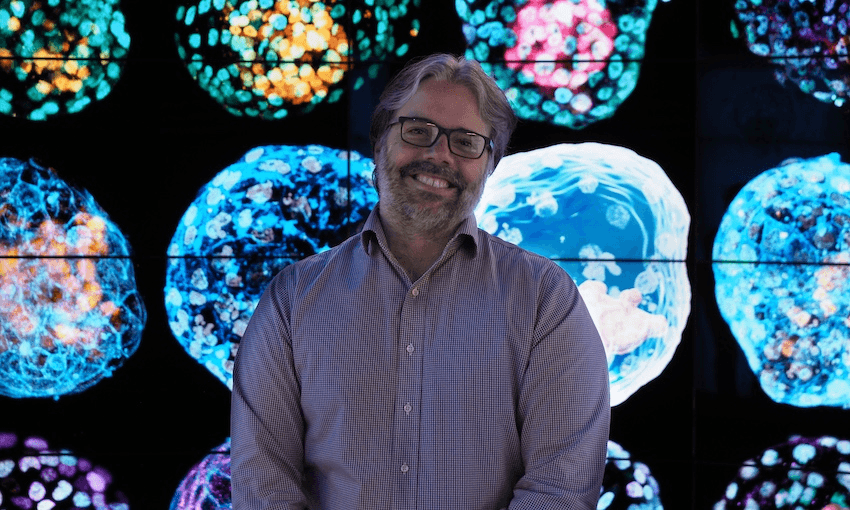A new embryo model could change the way scientists overseas research fertility and prenatal development, but the methods they use won’t fly here, reports Mirjam Guesgen.
Australian, US and Singaporean scientists have created a human embryo model that they think could make huge headway in understanding infertility, developmental diseases and miscarriage. But it may be beyond the reach of New Zealand scientists.
The embryo model, described today in the scientific journal Nature, was made by reprogramming skin cells into something similar to a blastocyst – a ball of cells that’s one of the earliest forms of an embryo.
The model, called iBlastoid, will give researchers the ability to study early developmental diseases, find ways to screen for and treat them, and offers tremendous potential for understanding infertility and miscarriages. Miscarriages remain something that doctors know very little about, yet affects a fifth (probably more) of New Zealanders.
“Because these iBlastoids are derived from skin cells generated in the laboratory many hundreds of them can be produced each day and used for meaningful experiments [that] would otherwise be impossible due to the limited availability and ethical issues around the use of human embryos for research,” said lead researcher Jose Polo from Monash University.
But this potentially life-changing, and life-giving, embryo model probably won’t be available to New Zealand scientists. Since the government has never approved guidelines for research using human embryos, there is effectively a ban on such research, even though it’s not prohibited by law.
The new model falls into a legal grey area, University of Otago medical ethicist Gareth Jones told The Spinoff, because the technology simply wasn’t conceivable when the laws governing embryo research were first made in the mid 1980s.
iBlastoids are pretty similar to human embryos made during conception except for a few vital differences. Those differences mean they can be used for research in Australia.
Unlike a human embryo that forms when an egg and a sperm combine, iBlastoids are made in the lab by reprogramming skin cells using a range of proteins and genes in a petri dish. Second, iBlastoids are missing a thick membrane around them that would normally help embryos implant themselves in the uterus.
Perhaps most importantly, the scientists meticulously watched how the iBlastoids developed, and found a raft of evidence that the model would only go through the early stages of development. The ball of cells didn’t fold inwards on itself, which would be the next step to becoming a viable human.
Limiting how much these embryo models can develop is crucial because under both international and Australian rules, embryos used for research can only develop up to 14 days after the egg and sperm combine, or up until the point when a structure called a primitive streak (which signals the very early beginnings of developing a nervous system) forms.
“[The researchers are] simply wanting to investigate what happens in very early human development. Surely there’s no problem with that because you haven’t started from a normal embryo… You’ve gone from adult tissue to embryo-like tissue,” said Jones. Nonetheless, previous experience leads Jones to think that the model couldn’t be used here.
The Human Assisted Reproductive Technologies Act regulates reproductive procedures in New Zealand, with the aim of protecting the wellbeing of people born through, or giving birth via, in-vitro fertilisation (IVF) or other procedures.
The act doesn’t state an outright ban on embryo experiments but researchers need to get approval from the ministerial ethics committee. The ethics committee acts on advice from a panel of experts, after consultation with the general public, and, in the end, it’s up to the minister of health to enact that advice.
In 2005 Jones was part of the committee that advised that embryo research should be allowed, within certain limits of course, but “that’s where everything has stalled,” he said. “Health ministers from both parties haven’t wanted to touch it. They think it’s a hot potato. It’s hanging in the air.”
Without guidance there’s in effect a blanket ban, he said.
Jones is among an influential group of New Zealand clinicians, biologists and social scientists who say that the ban is limiting improvements to reproductive technologies like IVF, which currently has a success rate of around 50% for a 30-year-old woman and closer to 10% for those over 40.
A paper Jones co-wrote in 2018 states that many researchers don’t even bother trying to do research in this area because they know they’ll be rejected by the ethics committee.
“It is apparent that New Zealand is missing out on opportunities in reproductive science and medicine with this current legislation in place,” the paper states.
Other research methods, such as using mouse models, do exist but “in the end mice are not human… So you’ve always got that jump. You’ve always got that uncertainty,” said Jones.
He and others in the reproductive biology sphere are calling for clarity from the ministry around the act. The iBlastoid model may renew those cries.
In response to questions from The Spinoff, minister of health Andrew Little said in an email: “I am aware of the issue and the matter is under consideration.”


